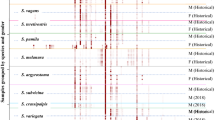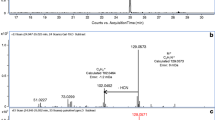Abstract
Insect cuticular hydrocarbons (CHCs) were probed by matrix-assisted laser desorption/ionization (MALDI) time-of-flight (TOF) mass spectrometry with a lithium 2,5-dihydroxybenzoate matrix. CHC profiles were obtained for 12 species of diverse insect taxa (termites, ants, a cockroach, and a flesh fly). MALDI spectra revealed the presence of high molecular weight CHCs on the insect cuticle. Hydrocarbons with more than 70 carbon atoms, both saturated and unsaturated, were detected. When compared with gas chromatography/mass spectrometry (GC/MS), MALDI-TOF covered a wider range of CHCs and enabled CHCs of considerably higher molecular weight to be detected. Good congruity between GC/MS and MALDI-TOF was observed in the overlapping region of molecular weights. Moreover, a number of previously undiscovered hydrocarbons were detected in the high mass range beyond the analytical capabilities of current GC/MS instruments. MALDI was shown to hold potential to become an alternative analytical method for insect CHC analyses. The ability of MALDI to discriminate among species varying in the degree of their relatedness was found to be similar to GC/MS. However, neither MALDI-MS nor GC/MS data were able to describe the phylogenetic relationships.







Similar content being viewed by others
References
Armold, M. T. and Regnier, F. E. 1975. A developmental study of the cuticular hydrocarbons of Sarcophaga bullata. J. Insect Physiol. 21:1827–1833.
Bagine, R. K. N., Brandl, R., and Kaib, M. 1994. Species delimitation in Macrotermes (Isoptera: Macrotermitidae): Evidence from epicuticular hydrocarbons, morphology, and ecology. Ann. Entomol. Soc. Am. 87:498–506.
Blomquist, G. J. and Dillwith, J. W. 1985. Cuticular lipids, pp. 117–154, in G.A. Kerkut, and L.I. Gilbert (eds.). Comprehensive Insect Physiology, Biochemistry and Pharmacology, vol. 3. Integument, Respiration and Circulation. Pergamon Press, Oxford.
Blomquist, G. J., Tillman, J. A., Mpuru, S., and Seybold, S. J. 1998. Nestmate recognition in termites, pp. 34–54, in R.K. Vander Meer, M.D. Breed, M.L. Winston, and K. Espelie (eds.). Pheromone Communication in Social Insects: Ants, Wasps, Bees and Termites. Westview Press, Boulder, CO.
Chapman, N. F. 1998. The Insects. Structure and Function. Cambridge University Press, Cambridge.
Clément, J.-L. and Bagnères, A.-G. 1998. Nestmate recognition in termites, pp. 125–155, in R.K. Vander Meer, M.D. Breed, M.L. Winston, and K. Espelie (eds.). Pheromone Communication in Social Insects: Ants, Wasps, Bees and Termites. Westview Press, Boulder, CO.
Cvačka, J. and Svatoš, A. 2003. Matrix-assisted laser desorption/ionization analysis of lipids and high molecular weight hydrocarbons with lithium 2,5-dihydroxybenzoate matrix. Rapid Commun. Mass Spectrom. 17:2203–2207.
Doolittle, R. E., Proveaux, A. T., Alborn, H. T., Heath, R. R. 1995. Quadrupole storage mass spectrometry of mono- and dimethylalkanes. J. Chem. Ecol. 21:1677–1695.
Dutta, T. K. and Harayama, S. 2001. Time-of-flight mass spectrometric analysis of high-molecular-weight alkanes in crude oil by silver nitrate chemical ionization after laser desorption. Anal. Chem. 73:864–869.
Esser, E., Keil, C., Braun, D., Montag, P., and Pasch, H. 2000. Matrix-assisted laser desorption/ionization mass spectrometry of synthetic polymers. 4. Coupling of size exclusion chromatography and MALDI-TOF using a spray-deposition interface. Polymer 41:4039–4046.
Golden, K. L., Meinke, L. J., and Stanley-Samuelson, D. W. 1992. Cuticular hydrocarbon discrimination of Diabrotica (Coleoptera: Chrysomelidae) sibling species. Ann. Entomol. Soc. Am. 85:561–570.
Grunshawn, J. P., Guermouche, H., Guermouche, S., Jago, N. D., Jullien, R., Knowles, E., and Perez, F. 1990. Chemical taxonomic studies of cuticular hydrocarbons in locusts of the Schistocerca americana complex: Chemical relationships between New World and Old World species. J. Chem. Ecol. 16:2835–3858.
Gush, T. J., Bentley, B. L., Prestwich, G. D., and Thorne, B. L. 1985. Chemical variation in defensive secretions of four species of Nasutitermes. Biochem. Syst. Ecol. 13:329–336.
Hadley, N. F. 1985. The Adaptive Role of Lipids in Biological Systems. Wiley, New York.
Hanton, S. D., Hyder, I. Z., Stets, J. R., Owens, K. G., Blair, W. R., Guttman, C. M., and Giuseppetti, A. A. 2004. Investigations of electrospray sample deposition for polymer MALDI mass spectrometry. J. Am. Soc. Mass Spectrom. 15:168–179.
Haverty, M. I., Nelson, L. J., and Page, M. 1990. Cuticular hydrocarbons of four populations of Coptotermes formosanus Shiraki in the United States. Similarities and origin of Introductions. J. Chem. Ecol. 16:1635–1647.
Haverty, M. I., Forschler, B. T., and Nelson, L. J. 1996. An assessment of the taxonomy of Reticulitermes (Isoptera: Rhinotermitidae) from the southeastern United States based on cuticular hydrocarbons. Sociobiology 28:287–318.
Haverty, M. I., and Nelson, L. J. 1997. Cuticular hydrocarbons of Reticulitermes (Isoptera: Rhinotermitidae) from Northern California indicate undescribed species. Comp. Biochem. Physiol. 118B:869–880.
Haverty, M. I., Woodrow, R.J., Nelson, L.J., and Grace, J.K. 2000. Cuticular hydrocarbons of termites of the Hawaiian Islands. J. Chem. Ecol. 26:1167–1191.
Howard, R. W., and Blomquist, G. J. 1982. Chemical ecology and biochemistry of insect hydrocarbons. Annu. Rev. Entomol. 27:149–172.
Howard, R. W., and Blomquist, G. J. 2005. Ecological, behavioral, and biochemical aspects of insect hydrocarbons. Annu. Rev. Entomol. 50:371–393.
Jackson, L. L. 1972. Cuticular lipids of insects. IV. Hydrocarbons of the cockroaches Periplaneta japonica and Periplaneta americana compared to other cockroach hydrocarbons. Comp. Biochem. Physiol. 41B:331–336.
Jackson, L. L., Armold, M.T. and, Regnier, F.E. 1974. Cuticular lipids of adult fleshflies, Sarcophaga bullata. Insect Biochem. 4:369–379.
Jackson, L. L., and Blomquist, G. J. 1976. Insect waxes, pp. 201–233, in P.E. Kolatukudy (ed.). Chemistry and Biochemistry of Natural Waxes. Elsevier, Amsterdam, Holland.
Kaib, M., Brandl, R., and Bagine, R. K. N. 1991. Cuticular hydrocarbon profiles: a valuable tool in termite taxonomy. Naturwissenschaften 78:176–179.
Katritzky, A.R., Chen. K., Maran. U., and Carlson, D. A. 2000. QSPR correlation and predictions of GC retention indexes for methyl-branched hydrocarbons produced by insects. Anal. Chem. 72:101–109.
Kuhn, G.,Weidner, S., Just, U., and Hohner, G. 1996. Characterization of technical waxes—comparison of chromatographic techniques and matrix-assisted laser-desorption/ionization mass spectrometry. J. Chromatogr. A 732:111–117.
Kutnik, M., Uva, P., Brinkworth, L., and Bagneres, A.-G., 2004. Phylogeography of two European Reticulitermes (Isoptera) species: the Iberian refugium. Mol. Ecol. 13: 3099–3113.
Lahav, S., Soroker, V., Hefetz, A., and Vander Meer, R. K. 1999. Direct behavioral evidence for hydrocarbons as ant recognition discriminators. Naturwissenschatfen 86:246–249.
Lenoir, A., D’Ettorre, P., Errard, C., and Hefetz, A. 2001. Chemical ecology and social parasitism in ants. Annu. Rev. Entomol. 46:573–599.
Lockey, K. H. 1985. Insect cuticular lipids. Comp. Biochem. Physiol. B 81:263–273.
Lockey, K. H. 1988. Lipids of the insect cuticle: Origin, composition and function. Comp. Biochem. Physiol. B 89:595–645.
Martin, M. M., MacConnell, J. G. 1970. The alkanes of the ant, Atta colombica. Tetrahedron 26:307–319.
Nei, M. 1972. Genetic distance estimates between populations. Am. Nat. 106:283–292.
Nelson, D. R., Dillwith, J. W., and Blomquist, G. J. 1981. Cuticular hydrocarbons of the housefly Musca domestica. Insect Biochem. 11:187–197.
Nowbahari, E., Lenoir, A., Clément, J.L., Lange, C., Bagnères, A.G., and Joulie, C. 1990. Individual, geographical and experimental variation of cuticular hydrocarbons of the ant Cataglyphis cursor (Hymenoptera: Formicidae): Their use in nest and subspecies recognition. Biochem. Syst. Ecol. 18:63–73.
Planeta, J., Řehulka, P., and Chmelík, J. 2002. Sample deposition device for off-line combination of supercritical fluid chromatography and matrix-assisted laser desorption/ionization time-of-flight mass spectrometry. Anal. Chem. 74:3911–3914.
Pruns, J. K., Vietzke, J.-P., Strassner, M., Rapp, C., Hintze, U., and König, W.A. 2002. Characterization of low molecular weight hydrocarbon oligomers by laser desorption/ionization time-of-flight mass spectrometry using a solvent-free sample preparation method. Rapid Commun. Mass Spectrom. 16:208–211.
Pruns, J. K., Rapp, C., Hintze, U., Wittern, K.-P., and König, W. A. 2003. Characterization of paraffin oils and petrolatum using LDI-TOF MS and principal component analysis. Eur. J. Lipid Sci. Technol. 105:275–280.
Ross, K. G., Vander Meer, R. K., Fletcher, D. J. C., and Vargo, E. J. 1987. Biochemical phenotypic and genetic studies of two introduced fire ants and their hybrid (Hymenoptera: Formicidae). Evolution 41:280–293.
Suiter, D. R., Carlson, D. A., Patterson, R. S., and Koehler, P. G. 1996. Host-location kairomone from Periplaneta americana (L.) for parasitoid Aprostocetus hagenowii (Ratzeburg). J. Chem. Ecol. 22:637–651.
Takahashi, S., and Gassa, A. 1995. Roles of cuticular hydrocarbons in intra- and interspecific recognition behavior of two Rhinotermitidae species. J. Chem. Ecol. 21:1837–1845.
Takematsu, Y., and Yamaoka, R. 1997. Taxonomy of Glyptotermes (Isoptera, Kalotermitidae) in Japan with reference to cuticular hydrocarbon analysis as chemotaxonomic characters. Esakia 37:1–14.
Vauchot, B., Provost, E., Bagneres, A. G., Riviere, G., Roux, M., and Clement, J. L. 1998. Differential adsorption of allospecific hydrocarbons by the cuticles of two termite species, Reticulitermes santonensis and R. lucifugus grassei, living in a mixed colony. J. Insect Physiol. 44:59–66.
Watson, J. A. L., Brown, W. V., Miller, L. R., Carter, F. L., and Lacey, M. J. 1989. Taxonomy of Heterotermes (Isoptera: Rhinotermitidae) in south-eastern Australia: Cuticular hydrocarbons of workers, and soldier and alate morphology. Syst. Entomol. 14:299–325.
Wigglesworth, V. B. 1965. The Principles of Insect Physiology. Methuen, London.
Yalcin, T., Schriemer, D. C., and Li, L. 1997. Matrix-assisted laser desorption ionization time-of-flight mass spectrometry for the analysis of polydienes. J. Am. Soc. Mass Spectrom. 8:1220–1229.
Acknowledgments
We gratefully acknowledge financial support provided by the Max Planck Institute, Jena, and the Institute of Organic Chemistry and Biochemistry, Prague (project Z4 0550506). The authors are indebted to Sybille Koch for technical assistance, to Dr. Karel Stránský for hydrocarbon standards and discussions, to Prof. Ivan Hrdý, Christian Kast, and Dr. Václav Stejskal for insect samples, and to Dr. Soňa Vašíčková and Dr. David Šaman for IR and NMR measurements.
Author information
Authors and Affiliations
Corresponding author
Rights and permissions
About this article
Cite this article
Cvačka, J., Jiroš, P., Šobotník, J. et al. Analysis of Insect Cuticular Hydrocarbons Using Matrix-Assisted Laser Desorption/Ionization Mass Spectrometry. J Chem Ecol 32, 409–434 (2006). https://doi.org/10.1007/s10886-005-9008-5
Received:
Revised:
Accepted:
Published:
Issue Date:
DOI: https://doi.org/10.1007/s10886-005-9008-5




